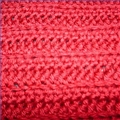
The art
of crochet allows people to make custom crochet patterns. These custom
crochet patterns can be used to make a rug exactly the length, width,
shape and color desired or a doily the exact the right proportions and
look for a coffee table. Creating custom patterns for a crochet project
is not as difficult as it sounds.
Difficulty: Easy
Instructions
Things You'll Need:
- yarn
- crochet hook
- scrap cardboard
- ruler
- scissors
- pen
-
1
 Stitch GaugeYarn and Crochet Hook
Stitch GaugeYarn and Crochet Hook
The yarn and crochet hook you use will determine the "gauge" of the finished work. Gauge is the height and width of your crochet stitches. Begin by selecting the yarn and hook you wish to use for your project. Make a sample swatch and measure the gauge of your stitches. In the example, worsted weight yarn was used with a size H, or 5.00 mm crochet hook. A swatch of two rows of double crochets was made. Each row was 9 double crochets wide. The two rows measured 1 1/2 inches high, so each row of double crochets is 3/4 of an inch high. The width of the swatch was 3 inches, so it takes 3 double crochet stitch to make one inch in the pattern.
-
2
 Trace Crochet PatternTracing the Pattern Outline
Trace Crochet PatternTracing the Pattern Outline
Using an old piece of repurposed cardboard or paper, trace an outline of the area the finished crochet piece should fit. This piece will be cut out and used as a template.
-
3
 Pattern TemplateLaying Out the Pattern
Pattern TemplateLaying Out the Pattern
Using the template prepared in the step above, mark out the rows and stitches. For example, we know from calculating our gauge that each row of stitches is 3/4 of an inch high, so on the template draw rows every 3/4 of an inch. Label the horizontal rows as row 1, row 2, row 3, etc., down the template.
Draw vertical lines 1 inch apart down the pattern template. When crocheting the project, each inch of width will equal three stitches based on our gauge. Count the number of squares in each row and record on the template how many double crochets are in each row of the template. In this example, each square in the row equals three double crochets, so the number of squares on the template times 3 would equal the number of stitches in each row.
On a pattern template that isn't perfectly square, such as the example, some partial squares will occur on the edge of each row. Estimate the number of stitches needed for partial squares. One third partial square would be equal to 1 stitch.
In the photo, each row was identified. Row 1, 2, 3, etc. Then, the number of double crochets needed in each row was recorded. This makes following the pattern easier. Enlarge the photo to see a sample of the rows and stitches per row recorded on the template.
-
4
 Crochet Project Layed Out on TemplateCrocheting the Project
Crochet Project Layed Out on TemplateCrocheting the Project
As you crochet, lay the project on the template periodically. Evaluate how the finished project fits the template. Adjust the crochet pattern if necessary.
Tips & Warnings
- The increase stitch and decrease stitch can be used to increase and decrease the number of double crochet stitches needed in each row.
No comments:
Post a Comment